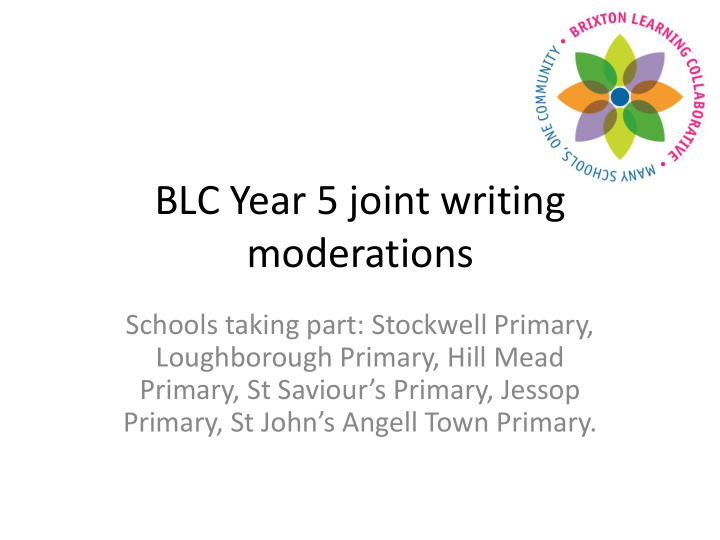



BLC Year 5 joint writing moderations Schools taking part: Stockwell Primary, Loughborough Primary, Hill Mead Primary, St Saviour’s Primary, Jessop Primary, St John’s Angell Town Primary.
The process • In June 2015, Year 5 teachers from Brixton Learning Collaborative schools met for an afternoon to jointly moderate writing from a case study child they judged to be ‘at’ age related expectation. The teachers worked with the New curriculum goals for writing, particularly focussing on the goals for Composition, with which to jointly moderate the case study examples. The case study work included examples both from literacy lessons and from other subject lessons. The following slides include examples of children’s work together with teacher’s explanations as to why they feel this work is at ARE. At the end of the presentation is a summary of the New Curriculum goals used in the moderation session. • It is hoped that this bank of examples will be useful to other year 5 teachers who wish to look at other children’s work judged by colleagues to be ‘at’ ARE. • Many thanks to all the teachers who took part and in particular to Becky Lawrence from Hill Mead Primary for leading the session.
Case study 1 – Stockwell Primary Y 5 • This child is working at the level expected of a Year 5 child because she is writing in sufficient quantity. Her voice is appropriate to the task (note the turns of phrase used in the newspaper report, the ogre report, the diary entries and the narrative). Her choice of vocabulary is expanding, seen particularly in the narrative story with choice verbs and adjectives for effect. Her voice and viewpoint are maintained in each piece. • She uses a range of sentence openers and connectives to ensure that her writing flows. She organises her writing into paragraphs correctly most of the time. • Why she is not above Age Related Expectations: • References need to be made between paragraphs • More examples of vocabulary chosen for effect, using vocabulary not normally associated with children of her age. • Writing is a little formulaic and lacks individual character/flair. • Secure use of punctuation (occasional capitalisation errors and too few examples of parentheses, semi-colon and colon usage).
Case study 2: Loughborough year 5 • This pupil has shown that they are writing at ARE because they are already doing the following things: • selecting appropriate grammar and vocabulary, understanding how such choices can change and enhance meaning. They have shown this in the difference in styles between the Sports description and the science prediction. • Proof reading for spelling and punctuation errors. This is evident in the work on the Aztec God. They have read through and edited their work accurately. • The pupil is beginning to: • identify the audience for and purpose of the writing, selecting the appropriate form and using other similar writing as models for their own. They have used examples modelled to them effectively. • ensure the consistent and correct use of tense throughout a piece of writing. They are nearly there but need to be a little more careful with this, particularly in writing in subjects other than literacy. • using a wide range of devices to build cohesion within and across paragraphs. • These would be the targets I would set this pupil for next year.
Case Study 3: St Saviours year 5 • The work was judged to be at expected for Year 5 because of the clear sense of writing for purpose and well chosen vocabulary. Sentences are of varied construction and sentence punctuation is mainly accurate. Tense is consistent and a range of conjunctions are used. • It is not above expected because use of paragraphing is not yet consistent.
Case study 4: St John’s Angell Town • This child is able to write her ideas down quickly. Her grammar, punctuation and spelling are mostly accurate. She has a good vocabulary and is able to use this to good effect, demonstrating understanding and enjoyment in her use of language. She is able to plan, draft and edit her writing across a range of genres and has a ' writer voice' evident in her work.
Case study 5 Hill Mead Primary • This writing is at ARE because the child is: • - Selecting appropriate grammar and vocabulary, understanding how such choices can change and enhance meaning • - in narratives, describing settings, characters and atmosphere and integrating dialogue to convey character and advance the action • - Beginning to demonstrate a secure understanding of cohesion between paragraphs • - able to assess the effectiveness of their own and others’ writing e.g. identifying and correcting repetition • - using mostly accurate spellings and precision in word choices • - able to recognise different registers in writing and produce formal and informal texts • - using variation of sentence structures • The writing is lively and engaging to the reader. There is a clear sense of audience and understanding of purpose.
Case study 6 Jessop Primary • This child is working at the level expected of a Year 5 child because of the clear sense of writing for purpose. Her grammar, punctuation and spelling are mostly accurate. She has a good vocabulary and is able to use this to good effect. The piece of writing has a very clear introduction and examples of persuasive techniques are evident throughout the text. Her work is not above expected because she still needs to develop using formal tone.
Recommend
More recommend